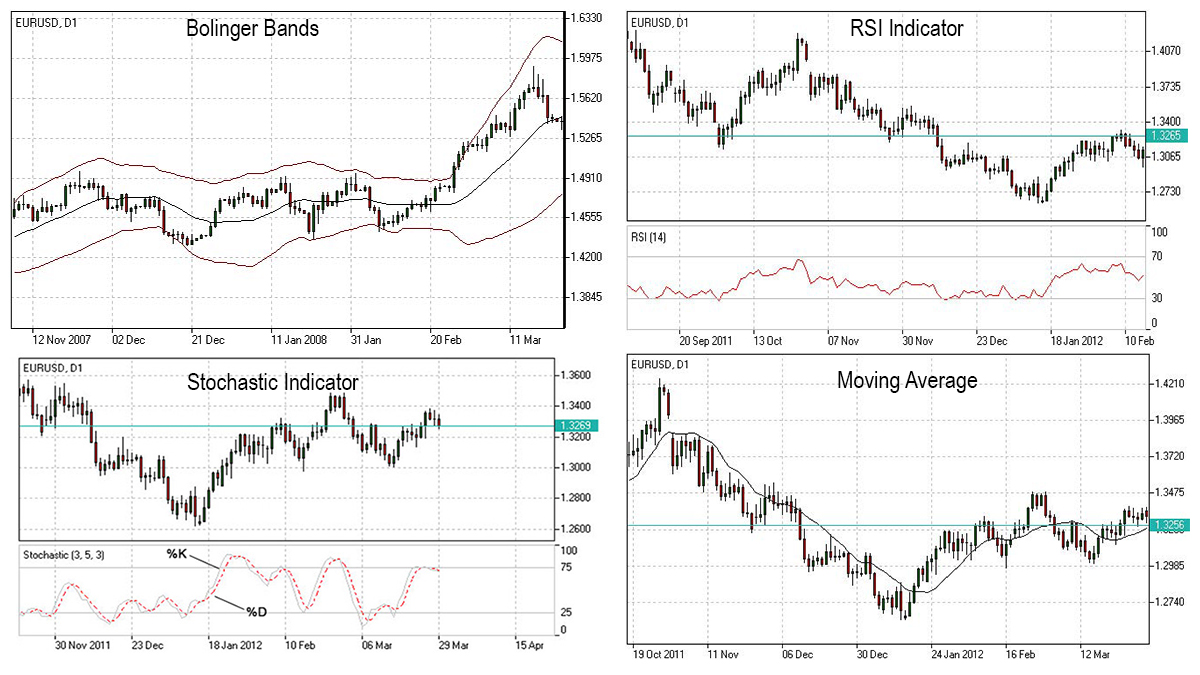- Education
- Forex Trading Strategies
- Strategies by Forex Analysis
- Technical Analysis Strategy
- Technical Indicators Trading Strategy
Technical Indicators Trading Strategy
Trading strategies often use technical indicators to determine entry, exit or trade management rules and sometimes strategies use more than just one indicator which helps to identify the moment trades should occur.
From this article, you will learn that even though the indicators and trading strategies are different, they are both used in tandem by technical analysts to determine trading setups with high probability. But if you are new to Forex trading, you can read our other article "What is Forex trading" and then continue reading about the technical indicators strategy.

KEY TAKEAWAYS
- Technical indicators are used to see past trends to anticipate future moves.
- There are several technical indicators that can be divided into two main categories: Overlays and Oscillators.
- Frequently, one of the indicators is used to confirm the other indicator's accuracy.
- With a wide variety of indicators at hand, traders should choose the indicators that work best for them and become familiar with how they work.
Technical Indicators Trading Strategy
First let’s understand what technical indicators are.
Technical indicators are pattern-based signals produced by the price, volume, and open interest rates of a security. Technical analysis is trading that helps to evaluate investments and identify trading opportunities by analyzing statistical trends gathered from trading activity.
When using indicators the goal is to identify trading opportunities. So the idea behind technical trading strategies is to find a strong trend followed by price rollback. Rollback should last for a short period of time, as soon as price retracement pauses trend will resume and continue moving in the direction of prevalent trend.
Traders when implementing strategies usually use trade filters and triggers which are most of the time based on indicators.
- Trade filters - when investing, a filter is used to narrow down the number of choices from a given set of securities.
- Тrade triggers - used to automate certain types of trades, such as the selling or buying shares when the price reaches a certain level.
For example Moving Average can be used to identify trade filters and trade triggers, like buying when price moves above the moving average and vice versa. Surely it doesn't stop there, there are a few more clarifications that need to be done, because a simple rule lacks definitive details for taking action, like - how far above the moving average does price need to move or What type of order will be used to place the trade. But now you get the idea, how indicators can be used in strategy.
An indicator stand alone is not a trading strategy. Indicators help understand the market, but a plan of implementation, so called rule book of investments and trading is strategy, where traders can use multiple technical indicators.
Main question for traders is to choose the right indicators for the strategy, since traders build their strategy based on the risk tolerance and preferences they have, indicators need to be chosen accordingly.
- A trader with long-term moves preferences and large profits might choose to focus on a trend-following strategy, therefore, will pick a moving average indicator as a stepping stone.
- A trader interested in short term transactions with frequent small gains might be inclined in a strategy based on volatility.
Note: Frequently, one of the indicators is used to confirm the other indicator's accuracy.
Technical Indicators Trading
- Overlays (are applied over the prices on the exchange chart)
- Moving Average - the reason for calculating the moving average of a stock is to help smooth out the price data by creating a constantly updated average price. Random, short-term fluctuations on the price of a stock over a specified time-frame are soften.
- Bollinger Bands - tool defined by a set of trend lines, applied two standard deviations (positively and negatively) away from a simple moving average (SMA) of a security's price. It gives investors a higher probability of properly identifying when an asset is oversold or overbought.
- Oscillators (are applied above or below a price chart)
- Stochastic Oscillator - is a momentum indicator comparing a particular closing price of a security to a range of its prices over a certain period of time. It is used to generate overbought and oversold trading signals, utilizing a 0–100 bounded range of values. The general idea is that in a market trending upward, prices will close near the high, and in a market trending downward, prices close near the low.
- Moving Average Convergence/Divergence (MACD) - is a trend-following momentum indicator that shows the relationship between two moving averages of a security’s price. MACD triggers technical signals when it crosses above (to buy) or below (to sell) its signal line. It helps investors understand whether the bullish or bearish movement in the price is strengthening or weakening.
- Relative Strength Index (RSI) - is a momentum indicator used in technical analysis that measures the magnitude of recent price changes to assess overbought or oversold conditions in the price of a stock or other asset. RSI is displayed as an oscillator, a line chart that moves between two extremes and can range from 0 to 100.
Bottom Line on Technical Indicators Trading Strategy
When analyzing a security, traders often use many different technical indicators. With a wide variety of indicators at hand, traders should choose the indicators that work best for them and become familiar with how they work. Traders can also combine technical indicators with more subjective forms of technical analysis, such as studying Forex chart patterns which will help to come up with trading ideas. Technical indicators can also be included into automated trading systems, given their quantitative nature.
In general, each trader should determine the correct method in which indicators will be used to signal trading opportunities and facilitate the development of a trading strategy.

